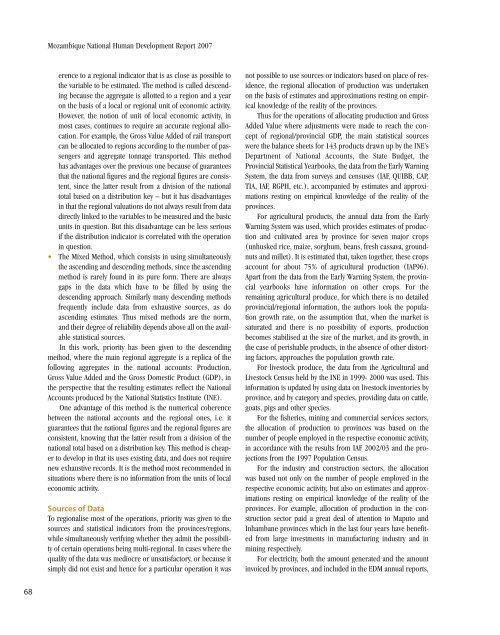English language version - Human Development Reports - United ...
English language version - Human Development Reports - United ...
English language version - Human Development Reports - United ...
- No tags were found...
You also want an ePaper? Increase the reach of your titles
YUMPU automatically turns print PDFs into web optimized ePapers that Google loves.
Mozambique National <strong>Human</strong> <strong>Development</strong> Report 2007erence to a regional indicator that is as close as possible tothe variable to be estimated. The method is called descendingbecause the aggregate is allotted to a region and a yearon the basis of a local or regional unit of economic activity.However, the notion of unit of local economic activity, inmost cases, continues to require an accurate regional allocation.For example, the Gross Value Added of rail transportcan be allocated to regions according to the number of passengersand aggregate tonnage transported. This methodhas advantages over the previous one because of guaranteesthat the national figures and the regional figures are consistent,since the latter result from a division of the nationaltotal based on a distribution key – but it has disadvantagesin that the regional valuations do not always result from datadirectly linked to the variables to be measured and the basicunits in question. But this disadvantage can be less seriousif the distribution indicator is correlated with the operationin question.• The Mixed Method, which consists in using simultaneouslythe ascending and descending methods, since the ascendingmethod is rarely found in its pure form. There are alwaysgaps in the data which have to be filled by using thedescending approach. Similarly many descending methodsfrequently include data from exhaustive sources, as doascending estimates. Thus mixed methods are the norm,and their degree of reliability depends above all on the availablestatistical sources.In this work, priority has been given to the descendingmethod, where the main regional aggregate is a replica of thefollowing aggregates in the national accounts: Production,Gross Value Added and the Gross Domestic Product (GDP), inthe perspective that the resulting estimates reflect the NationalAccounts produced by the National Statistics Institute (INE).One advantage of this method is the numerical coherencebetween the national accounts and the regional ones, i.e. itguarantees that the national figures and the regional figures areconsistent, knowing that the latter result from a division of thenational total based on a distribution key. This method is cheaperto develop in that its uses existing data, and does not requirenew exhaustive records. It is the method most recommended insituations where there is no information from the units of localeconomic activity.Sources of DataTo regionalise most of the operations, priority was given to thesources and statistical indicators from the provinces/regions,while simultaneously verifying whether they admit the possibilityof certain operations being multi-regional. In cases where thequality of the data was mediocre or unsatisfactory, or because itsimply did not exist and hence for a particular operation it wasnot possible to use sources or indicators based on place of residence,the regional allocation of production was undertakenon the basis of estimates and approximations resting on empiricalknowledge of the reality of the provinces.Thus for the operations of allocating production and GrossAdded Value where adjustments were made to reach the conceptof regional/provincial GDP, the main statistical sourceswere the balance sheets for 143 products drawn up by the INE’sDepartment of National Accounts, the State Budget, theProvincial Statistical Yearbooks, the data from the Early WarningSystem, the data from surveys and censuses (IAF, QUIBB, CAP,TIA, IAF, RGPH, etc.), accompanied by estimates and approximationsresting on empirical knowledge of the reality of theprovinces.For agricultural products, the annual data from the EarlyWarning System was used, which provides estimates of productionand cultivated area by province for seven major crops(unhusked rice, maize, sorghum, beans, fresh cassava, groundnutsand millet). It is estimated that, taken together, these cropsaccount for about 75% of agricultural production (IAF96).Apart from the data from the Early Warning System, the provincialyearbooks have information on other crops. For theremaining agricultural produce, for which there is no detailedprovincial/regional information, the authors took the populationgrowth rate, on the assumption that, when the market issaturated and there is no possibility of exports, productionbecomes stabilised at the size of the market, and its growth, inthe case of perishable products, in the absence of other distortingfactors, approaches the population growth rate.For livestock produce, the data from the Agricultural andLivestock Census held by the INE in 1999- 2000 was used. Thisinformation is updated by using data on livestock inventories byprovince, and by category and species, providing data on cattle,goats, pigs and other species.For the fisheries, mining and commercial services sectors,the allocation of production to provinces was based on thenumber of people employed in the respective economic activity,in accordance with the results from IAF 2002/03 and the projectionsfrom the 1997 Population Census.For the industry and construction sectors, the allocationwas based not only on the number of people employed in therespective economic activity, but also on estimates and approximationsresting on empirical knowledge of the reality of theprovinces. For example, allocation of production in the constructionsector paid a great deal of attention to Maputo andInhambane provinces which in the last four years have benefitedfrom large investments in manufacturing industry and inmining respectively.For electricity, both the amount generated and the amountinvoiced by provinces, and included in the EDM annual reports,68
















